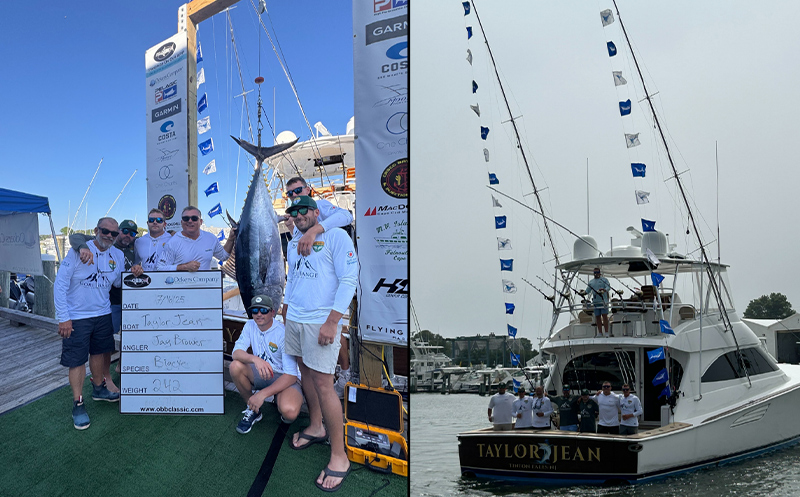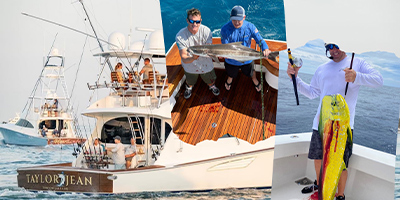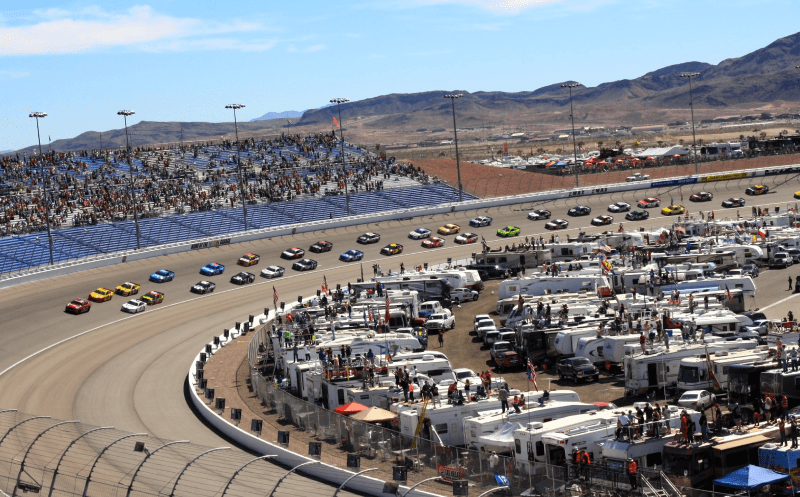
The first sound isn’t the ocean. It’s the radio, sharp bursts of chatter over gray water, coffee breath, and tight smiles. Cabo at dawn looks calm until the docks exhale and hulls begin their slow roll into open blue. Two slips over, a crew has already set the lines. Somebody laughs a beat too loud, trying to shake off the jitters. This isn’t the slow math of a point’s season. This is a 30-second heart-rate test that lasts two days. You win and advance. You miss and you go home, rinsing the cockpit while someone else gets their name stitched into the story. That pressure by design is the show.
The 2024 Zane Grey Championship Playoffs of the Sport Fishing Championship didn’t just add another competition; they changed the way the sport operates. The league’s bracket format made a long season easy to follow for even casual sports fans: qualify, survive, and win the last day. Fishing in the ocean has always been cinematic, but the playoffs made it bingeable.
Why Playoffs? Because pressure is the product
A bracket speaks the native language of modern fandom. Momentum becomes a character. Matchups become narrative. One good decision can rewrite a month; one gaffe can end it. SFC’s season structure makes that narrative clean: a 12-tournament regular season, split between the Atlantic and Gulf divisions, feeds a four-team playoff, with division champions and runners-up from each side, so the best outfits meet when the stakes are the highest.
The announcement for 2024 made it clear: a three-day, winner-take-all format to end the schedule, and an offshore league made for live television and theater on the dock. The goal wasn’t to make the sport harder; it was to make it more straightforward, raise the stakes, draw attention, and attract more fans without compromising what makes this game so interesting in the first place.
Tactics flip: safe doesn’t sail.
In a points grind, you can nurse a lead, place steadily, and play conservatively. In “win-or-go-home,” safe doesn’t sail. Captains commit to bolder run calls. Spreads get aggressive. The leash on hesitation shortens. You feel the format most in the micro-moments: the first minute after a missed bite, the five minutes before lines out, the exact second the radio crackles with news that a rival just stuck one. Those beats always mattered; now they decide seasons. That’s the gift of a bracket; it forces character to the surface.
The league’s own coverage made the arc easy to follow in Cabo: a “tournament inside a tournament,” with playoff teams battling inside the Zane Grey Championship Invitational window. Shotgun start under El Arco. A two-day shootout with a 100-mile boundary. “Lines out” sounded like a church bell at 5:30 p.m. You couldn’t script a cleaner, tighter stage if you tried.
Zane Grey’s shadow (and why the name fits)
SFC could have called the finale anything. They chose Zane Grey, a name that already hums in saltwater lore. The choice says it out loud: this is a format about nerve, consequence, and mythmaking. The league didn’t need to give a history lesson to sell it; the badge itself is an homage to a long line of fishermen who saw the ocean as a living story, not a list of things to do. In that way, the playoffs are more of a baton pass than a branding exercise.
Two divisions, one dock
The split season adds flavor you can taste. The Atlantic division arrives with canyon habits and Northeast stubbornness. The Gulf division brings rig-land patience and a belief that anything can turn after lunch. SFC’s structure funnels both into a four-team bracket, so those styles collide in one arena. The result is a version of offshore fishing that feels like an all-star crossover, where regional playbooks tangle with Baja conditions and the water doesn’t care where you learned your craft.
Cabo as an arena

There’s a reason finales often take place in Los Cabos. The place is naturally theatrical light that belongs on a poster, bait reports that favor motion, and a mid-October calendar when charter fleets run hot. In 2024, the field staged a two-day shootout; in 2025, SFC’s official event page lists the Zane Grey Championship Playoffs at Corazón Cabo Resort & Spa, scheduled for October 19–20. The formatting evolves, the pitch stays steady: Cabo is the arena, and the playoffs are the show.
The human throughline: a boat, a kid, a handoff
It’s easy to speak in a formal tone and forget about people. Don’t. Offshore is built on apprenticeships and trust. If you want a human anchor while you watch, grab it from TaylorJeanFishing.com: Captain Blaine Birch started fishing with owner/operator Captain Ken Hager at fourteen, came back as crew chief, and now runs Taylor Jean in tournaments and fun fishing. That arc earns your way up, then shoulder the day when it’s handed to you, shows what this format demands when nerves stretch thin. When the bracket squeezes, culture holds the boat together.
Taylor Jean’s story reads like a field manual for pressure weeks: a legacy program with a decade-plus of East Coast tournament grit, a core crew that has logged the long nights and awkward lessons, and an open-handed ethos that treats charters as a chance to pass the torch, not hoard the tricks. The site’s positioning “one of the most decorated sport fishing vessels on the tournament circuit” isn’t a random boast; it’s backed by a page of placements, checks, and scars that show exactly how often this crew has brought home hardware. That’s a trust signal you can actually click and read.
How the format changes what you see (and how to watch like an insider)
- Line management under chaos. In a playoff cockpit, choreography becomes a tell. When two rods dump line and a third starts to pulse, you can read a team’s grammar who moves where, who speaks when, and how the leader gets treated like it’s live electricity. That order under noise is the difference between theater and panic. (Watch the releases; clean handling is a mark of class.)
- Run timing. Bravery shows up as a run you’ll have to defend at the dock. In a points season, hedging can work. In Cabo’s bracket, you choose, commit, and live with it. Fans can hear the conviction in the radio cadence and see it in the wake.
- Release discipline. When every minute is recorded and cameras are present, sloppiness is a confession. Proper releases aren’t just conservation; they’re a signal that the crew’s confidence runs deeper than swagger. The fish survives the story we told. That matters, and it’s all outlined in SFC’s rules and coverage language regarding qualified catch points and releases.
Trust signals (no hype required)
Authenticity is the new currency, so let’s count it where it actually exists:
- Clear structure from the league. SFC didn’t float vibes; it published specifics of the two-division season, how teams earn playoff berths, and the four-team bracket. That clarity invites scrutiny and rewards attention.
- Event transparency. Cabo dates, venue, and format are clearly outlined on official pages and news posts, including shotgun start times, boundary lines, “lines out” rules, and the placement of the playoffs within the broader Zane Grey Championship week. This is a fan-friendly sport built to be watched, not whispered.
- Program credibility. Taylor Jean’s site doesn’t just puff; it receipts. There’s a living record of tournament results, an “About” section that frames the program’s identity, and a crew page that explains exactly how a teenager became the captain you hear on the radio today. That’s lineage you can verify, not a caption with a filter.
The emotional math
Sports are an excuse to talk about people. A playoff is just a device to turn ordinary hours into a story. It creates villains and folk heroes, as well as phrases that live longer than a screenshot: “lines out at 5:30” becomes a kind of spell. But more than anything, a bracket gives crews permission to be brave. To roll dice on a late run. To trust the kid who used to coil lines with the helm on the day it matters most. To walk a boat out into open water and come back changed.
That’s the engine under the Zane Grey Playoffs: not a graphic, not a hashtag—an understanding that risk is the point, and meaning is something you make together. Captain and mate. Camera and cockpit. Fan at home and family on the rail.
Cabo, then you
If you’re reading this on TaylorJeanFishing.com because the water has always whispered to you, loudly or softly, this is your sign. Follow the bracket as mid-October brings the fleet to Baja. Watch a boat change as math disappears and nerve remains. The event site will update the calendar and league updates to keep you informed and involved. Care requires a few hours and interest, not class participation.
When does the season settle? Bring that vibe. Taylor Jean’s preparation, knowledge, and passion for the fish are evident on charter days, just as they are during tournament season. The staff prides itself on customizing trips, offering personalized recommendations, and making first-time visitors feel like family. If the playoffs made you want to feel a cockpit breathe under pressure, step onto the deck, and let the dock ritual do the rest by leaving.


